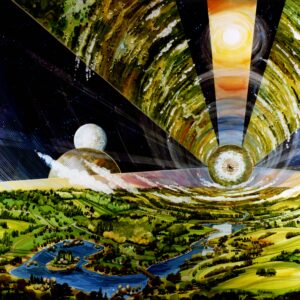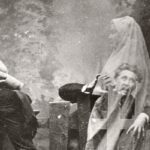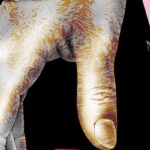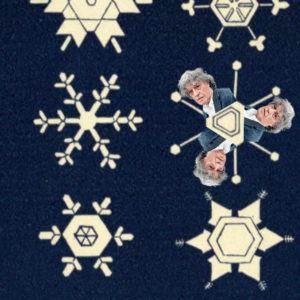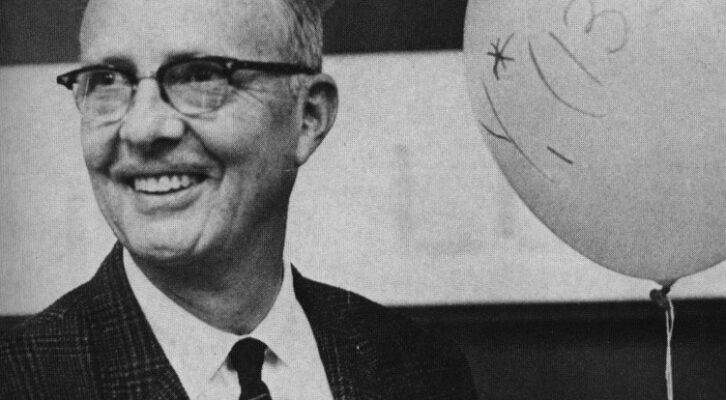
The Scientific Detective: How Luis W. Alvarez Pursued Theory Through Practice
Alec Nevala-Lee on the Nobel Prize-Winning Physicist's Experimental Approach to Scientific Inquiry
“Successful physics is basically antisocial, in that it involves showing where the most illustrious physicists of the past have been wrong.”
Article continues after advertisement–Luis W. Alvarez
*
On May 31, 1970, the physicist Luis W. Alvarez took his family on a field trip to the San Leandro Rifle Range. He parked his car just outside a fenced wedge of overgrown grass and scrub that covered half an acre of shoreline, where a narrow sliver of San Francisco Bay extended into the land like a pointing finger. It was a pleasant drive of about half an hour from his workplace at the Lawrence Radiation Laboratory in Berkeley, which made it a convenient location for him to dramatically demonstrate his theory about the death of a president.
As Alvarez emerged from the driver’s seat, the weather seemed perfect for a Sunday excursion. He was fifty-eight and casually dressed in a collared shirt with short sleeves, which would have made him look equally at home in an accountant’s office or at a console for the launch of a spacecraft. A lean six foot two, he was no longer the skilled gymnast of his youth—most of his exercise these days was confined to the golf course—but he was still an imposing figure, with fine blond hair receding from a high forehead and piercing blue eyes behind browline glasses.
Charismatic, physically agile, and daring, Alvarez was one of the last representatives of an era that could still see physics as a heroic enterprise.
Beside him was Janet, his second wife, who was two decades younger and smartly attired in shades, a plaid sunhat, and a sleeveless blouse. In her arms Janet carried Helen, their two-year-old daughter, while their son, Donald, who was four, brandished a toy bow and arrow. They stood back as Alvarez issued instructions to the younger colleagues who were setting up his experiment. Paul Hoch, a bearded graduate student from Berkeley, tossed one of their targets—a small melon—playfully into the air. Another key participant was Sharon “Buck” Buckingham, a lab technician who was also an enthusiastic deer hunter.
While a third associate, Don Olson, positioned a camera, the others prepared the melons, which were wrapped in two-inch fiberglass tape to better approximate the qualities of a human skull. A wooden stand was set about thirty yards from the covered firing station in the shooting lane, where a marksman named Dewey Machinelli stood with a .30-06 rifle. The first three melons would be placed on the ground, while another four would be balanced or suspended on the target itself.
As the others withdrew, Machinelli aimed through his scope at the first melon. Alvarez watched intently to see how it would react to the bullet. Common sense dictated that it would be driven away from the shooter, but he predicted that it would move in the opposite direction—toward the source of the gunshot. It seemed paradoxical, but if he was right, it would illuminate a crucial point in the most controversial murder investigation in American history.
Unlike most of the amateur detectives who obsessed over the assassination of John F. Kennedy, Alvarez had a personal connection to the victim. Although his politics were usually on the conservative side, he had registered as a Democrat in 1960 out of enthusiasm for the dynamic young candidate—six years his junior—whom he later described as “very much a hero of mine.”
Alvarez, who met President Kennedy twice, was shattered by the events of November 22, 1963. He naturally sympathized with the Warren Commission—he had served on similar committees himself—and accepted its conclusion that Lee Harvey Oswald had acted alone. Doubts would soon arise over the lone gunman theory, but Alvarez avoided being drawn into the debate for another three years.
In 1966, on the day before Thanksgiving, Alvarez listened over lunch as his graduate students argued about the current cover story in Life magazine, “A Matter of Reasonable Doubt.” It featured the best stills ever published of the home movie taken by eyewitness Abraham Zapruder, which offered the clearest record of the crime scene in Dallas. Recognizing it at once as the kind of problem that he knew best, Alvarez reviewed the article at home, examining the pictures with typical fervor: “I got very little sleep that long holiday weekend.”
Although Alvarez had no professional background in forensic analysis, he was confident in his ability to extract new information from some of the most scrutinized images of all time. For years, he had studied photos from the hydrogen bubble chamber, the massively complicated machine that he had designed to record the tracks of subatomic particles. Now he redirected those skills toward the Zapruder film, finding visual evidence in the stills to determine the timing of the shots, the frame rate, and the speed of the limousine.
It was an ingenious piece of detective work, but not every question could be resolved solely with photographs. Hoch, his graduate student, was part of an informal network of Warren Commission critics. When Alvarez later asked what he thought was the best evidence for a conspiracy, Hoch said, “The head snap.” At the fatal third shot, Kennedy’s head moved back and to the left, which seemed to reflect an impact from the front. This backward—or retrograde—movement was inconsistent with Oswald’s position to the rear in the Texas School Book Depository, pointing instead to a shooter on the infamous grassy knoll.
If the shot came from the back, a lone gunman was still possible; if it came from the front, there must have been a second shooter—and, by definition, a conspiracy. Anyone who believed that Oswald had acted alone needed to account for the motion of the president’s head. After Alvarez speculated that Kennedy had simply fallen backward when his neck muscles went limp, Hoch handed him the book Six Seconds in Dallas by Josiah Thompson, which made an exceptionally strong case for a conspiracy based on the physical evidence.
Although he rejected the book’s conclusions, Alvarez respected its approach. In February 1969, he flew to a meeting of the American Physical Society in St. Louis, which he was attending for the first time since winning the Nobel Prize the year before. As he read Thompson’s book on the plane, he was impressed by its diagrams, which led him to agree that the conspiracy theorists were right about one thing: “The president’s head did not fall but was driven back by some real force.”
In his hotel suite, he worked out a solution on a sheet of scrap paper. “Since I knew more physics than the [conspiracy] buffs,” Alvarez said, “it didn’t take me long.” The answer, he felt, was surprisingly simple, once you corrected for a mistaken assumption. Most observers treated the impact as though it involved only two bodies—the bullet and the skull—in an inelastic collision, in which most of the kinetic energy was dissipated as heat. Alvarez realized that it might work differently in practice, largely because of a third factor that had to be taken into account.
Rather than transferring all its momentum to the head, a bullet would lose most of its energy in a burst of debris, as the skull’s contents exploded outward. If the spray of brain matter seen in the Zapruder film was moving in the same direction as the gunshot, it could carry greater momentum than the bullet itself, requiring a motion in the opposite direction. Counterintuitively, the head would be thrust back, like a rocket ejecting its propellant. The jet effect, Alvarez concluded, could explain the backward snap without a shot from the front.
When Alvarez returned to Berkeley, he shared his work with his colleagues, one of whom recalled that the response was “tepid.” His calculations were elegant, but there was no guarantee that they correctly described a phenomenon in the real world. Hoch soon convinced him that he wouldn’t persuade the skeptics “unless we could demonstrate the retrograde recoil on a firing range using a reasonable facsimile of a human head as a target.”
In response, Alvarez organized the series of tests that ended with his visit to the San Leandro shooting range in May 1970. As he invited his family to watch, the rifleman shot seven melons. Six rocketed back in the direction of the shooter, exactly as he had predicted. When Alvarez publicized his findings, they seemed like a scientific vindication of the Warren Commission’s conclusions.
What almost no one knew was that the published results—while accurate—were only part of the story. By carefully planning the final demonstration, Alvarez obtained the outcome that he wanted, and he never mentioned a pair of earlier attempts that were much less definitive. As he later wrote in another context, “Many people think that solving a scientific puzzle is an exercise in logic that could be carried out equally well by a computer. To the contrary, a scientific detective’s main stock-in-trade is his ability to decide which evidence to ignore.”
*
At the peak of his fame, Alvarez was one of the world’s most prominent scientists—a Nobel laureate whose career ranged from Hiroshima to the extinction of the dinosaurs. Today, however, he might best be known for a short scene in Christopher Nolan’s Oppenheimer. Early in the movie, the physicist J. Robert Oppenheimer is strolling down a sidewalk in Berkeley with his lover, Jean Tatlock, when he sees a familiar figure rush out of a barber shop. Leaving Tatlock behind, Oppenheimer runs after his colleague, calling his name: “Alvarez?”
At the lab, Alvarez excitedly shows Oppenheimer and Ernest Lawrence, his mentor, a newspaper article announcing that two German chemists have split the atom. As Alvarez dashes out of the room, hoping to reproduce the experiment, Oppenheimer heads for the blackboard, which he fills with equations to demonstrate that the fission reaction is impossible. After seeing the proof, Lawrence advises him to go next door, saying gleefully, “Alvarez did it.”
In the next shot, Oppenheimer watches as Alvarez shows him a series of spiking pulses on an oscilloscope, indicating that fission is indeed taking place. Understanding its significance at once, Oppenheimer confers with Lawrence, who agrees that everyone who sees it will be thinking the same thing. Glancing uncertainly between the two other men, Alvarez asks, “What are we all thinking?” Oppenheimer responds dryly, “A bomb, Alvarez. A bomb.”
Aside from a few minor departures from the facts, the scene is remarkably accurate, even if the actor Alex Wolff bears minimal resemblance to the real Alvarez, who was tall, blond, and blue-eyed. Confusion over his background would persist after his death, but the truth, as the scholar Jesús Rubén Martínez wrote, was straightforward enough: “Alvarez was a white man with a Hispanic name.”
After his brief appearance in the film, Alvarez vanishes from it entirely, leaving the casual viewer without any hint of the stunning career that would follow. A 1957 profile in Time magazine called Alvarez the field’s “prize wild-idea man,” while Glenn Seaborg, a fellow Nobel winner, hailed him as “the most creative and versatile scientist I have ever known.” Richard Muller, his longtime protégé, went further: “Luie Alvarez, I think, if you took a survey of physicists, could probably win the most votes for being the greatest experimental physicist of the twentieth century.”
Perhaps the most revealing tribute of all came from Richard Feynman. In 1986, while serving on the commission to investigate the Challenger disaster, Feynman conceived of a famous demonstration—involving a piece of rubber and a glass of ice water—to show that the O-ring seals in the space shuttle’s rockets became unreliable at low temperatures. At first, he was hesitant to perform it in public. “But then I think of Luis Alvarez, the physicist,” Feynman recalled. “He’s a guy I admire for his gutsiness and sense of humor, and I think, ‘If Alvarez was on this commission, he would do it, and that’s good enough for me.’ ”
Charismatic, physically agile, and daring, Alvarez was one of the last representatives of an era that could still see physics as a heroic enterprise. He sought new challenges in the most fascinating places imaginable, from the Great Pyramids to the Cretaceous mass extinction, which became his single greatest triumph. Reasoning brilliantly from the evidence, he concluded that the dinosaurs were doomed by an impact from space, igniting a furious debate that consumed the last years of his life.
His story is inseparable from the rise of experimental physics, which he ushered into its modern age. Even more than Oppenheimer or Lawrence, Alvarez offers the best imaginable introduction to its tools and secrets. As an experimenter, not a theorist, he thought with analogies, rather than mathematics, making his work highly accessible. While scientists in the lab rarely achieve the fame of their theoretical counterparts, the experimentalists, as Alvarez noted, have the last word on whether a theory is valid: “The only correct way to find out is to appeal to experiment.”
Alvarez has been described as a scientific Indiana Jones, but his reputation as a maverick was built on a foundation of patience and discipline. “In the fields of observation,” Louis Pasteur said, “chance favors only the prepared mind.” To take advantage of luck, Alvarez had to remain constantly at the ready. He positioned himself to benefit from happy accidents, and many of his discoveries resulted from taking the trouble to understand a surprising result.
Alvarez has been described as a scientific Indiana Jones, but his reputation as a maverick was built on a foundation of patience and discipline.
Physics was full of these opportunities, but only for those who could recognize them. Alvarez had a “killer instinct” for noticing what others had overlooked—what one associate called “a sort of genius for moving about and trying to see if there’s one place that’s an obvious bottleneck”—and refused to leave it to chance. Every week, Muller said, “Luie set aside two hours to think about what he had learned, and if they could apply to any of the unsolved problems that he knew in physics, technology, or world affairs.” As Alvarez put it, “If someone thinks of a key, I can fit it into something. I have in my mind dozens of experiments which need one missing piece.”
One colleague marveled that Alvarez could generate enough ideas for a hundred people: “That’s what they have him there for.” Another commented, “Although Luie might have one hundred ideas each day, fifty were probably useless, another twenty-five too difficult to do, and among the remaining twenty-five one or two would be worth a Nobel Prize.” Muller noted that it was a deliberate strategy: “Luie had taught me that most clever ideas are proven to be wrong within a few days. If you manage to have one good idea every week, then you can expect to find one every few months that is really worth pursuing.”
And none of it would have mattered if he had lacked the technical ability to realize his hunches. After mastering the arts of the machinist and glassblower, he applied himself with equal diligence to accelerator physics. He also molded himself into a relentless leader of teams, which in his hands became another tool. As the historian Peter Galison has written, Alvarez did for peacetime science what Andy Warhol did for art, turning it from a solitary pursuit into a factory. By combining the bubble chamber with the computer, he created a machine for generating serendipity.
A conventional scientist might have been content to keep mining this rich vein of material, but in an unprecedented change of heart, Alvarez turned his back on it. When the process became routine, he pivoted to problems that were unsolvable by computational power alone, as if to demonstrate the value of individual insight. Late in life, he became nothing less than the world’s foremost scientific detective, which was a calling that he could pursue on his own terms.
As a result, Alvarez was one of the few experimental physicists who excelled at every stage. At a time when scientific knowledge was expanding rapidly, he resisted specialization, with what Muller called “a knack for learning just the right amount about everything.” His persistence was powered by an unusual ability to live with uncertainty. He was realistic enough to prefer problems with a high potential reward, but he still relished the praise of a colleague who said, “You have a greater tolerance for risk than anyone I’ve ever known.”
Alvarez knew that a comprehensive account of his life would double as a kind of manual on how to succeed in physics, and he labored over a book that told his side of the story. Once, at a dinner party, he fell into conversation with the wife of his rival Emilio Segrè, who was preparing a memoir of his own. When Rosa Segrè asked if he spent a lot of time reading old letters, Alvarez responded, “Oh, no, I just write down what I remember.”
In 1987, the year before he died, his autobiography was published by Basic Books. Alvarez: Adventures of a Physicist was an engaging tour of the highlights of his career, but it was equally notable for its omissions. After his death, the astrophysicist George Greenstein mentioned him to a colleague, who replied, “Luis Alvarez—wasn’t he that son of a bitch out at Berkeley?” And when Greenstein asked if Alvarez had really been “a son of a bitch,” the response spoke volumes: “Well, I never knew him personally, but I understand that he was.”
__________________________________
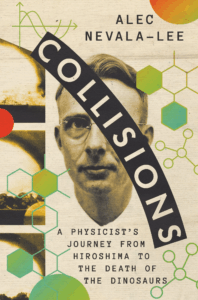
Reprinted from Collisions: A Physicist’s Journey from Hiroshima to the Death of the Dinosaurs by Alec Nevala-Lee. Copyright © 2025 by Alec Nevala-Lee. Used with permission of the publisher, W. W. Norton & Company, Inc. All rights reserved.
Alec Nevala-Lee
Alec Nevala-Lee is the author of Inventor of the Future: The Visionary Life of Buckminster Fuller and the Hugo Award finalist Astounding: John W. Campbell, Isaac Asimov, Robert A. Heinlein, L. Ron Hubbard, and the Golden Age of Science Fiction. His nonfiction has appeared in print and online in such publications as the New York Times, the Atlantic, Slate, Salon, and the Daily Beast. He lives with his wife, the NPR host Wailin Wong, and their daughter in Oak Park, Illinois.









